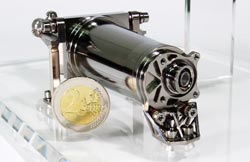LZH for the 10th Time at Photonics West: space lasers, fiber optics, single frequency lasers, ultrashort pulse lasers

The new MOMA prototype model.<br>
The Laser Development Department of the LZH will be presenting systems and components from the fields of space lasers, fiber optics, single frequency lasers and ultrashort pulse lasers in North Hall at stand 4601.
Since the first German Pavilion at Photonics West in 2004, it has developed into the largest stand there, presently with 58 exhibitors, and is certainly a crowd puller for visitors from all over the world. The organizers of the most important fair for lasers and photonics are expecting around 20,000 visitors and over 1,200 exhibitors.
Fresh from the labs: The new prototype of the MOMA-APM laser head for the Exomars Mission 2018
An important step in the preparations for looking for traces of organic substances on Mars during the Exomars Mission 2018 has been taken. The fundamental design of a flight model of a diode-pumped, Q-switched laser which emits nanosecond pulses in the UV range at a wavelength of 266 nm in outer space has been developed for the new prototype of the MOMA-APM laser head (Mars Organic Molecule Analyzers Advanced Prototype Model). This laser head, which was developed by the Space Technologies Group, will be used as the excitation source in the laser desorption mass spectrometer of the MOMA system, and it generates ions from organic molecules which cannot be vaporized. The ions can then examined in the MOMA mass spectrometer.
Premier at the fair: A wavelength multiplexer for 633 and 1550 nm
The Fiber Optics Group is presenting the newest fiber components and integrated fiber amplifiers, among which is a coupler for monomode fibers, a pump light combiner, and a fiber cladding mode stripper for the wavelengths between 0.6 and 2.1 µm. For the first time, a wavelength multiplexer consisting of two different fibers will be shown, which combines the wavelengths of 633 nm and 1550 nm. Combining the light fields of different fibers opens new applications, for example in medical technology.
Also, a highly integrated, ytterbium-doped fiber amplifier will be shown, which was developed for the detection of gravitational waves using interferometry, and which has a line width of only a few kilohertz, an emission wavelength of 1064 nm and an average output of over 200 W. Further application fields for this prototype are coherent beam combinations, laser metrology, and investigations on quantum optical phenomena, and nonlinear optics.
Infrared laser with a wavelength of 1.95 µm for the microprocessing of Plastics
A result of the EU project IMPROV (Innovative Mid-infrared high Power source for Resonant ablation of Organic photoVoltaic devices; Grant Agreement No. 257893) will be presented by the Ultrafast Photonics Group, the third prototype of the IMPROV laser with a wavelength of 1.95 µm. By using very narrow band gratings, the laser produces laser pulse lengths between 250 and 550 ps, and has a high quality spectrum. The system is an excellent laser source for downstream fiber amplifiers, and the pulses can be amplified without pre-time-stretching in the fiber. First experiments show that energy in the µJ range could be reached with a single fiber amplifier. Based on polarization-maintaining fibers, the laser output is stable, even when there are external influences, such as temperature fluctuations. Due to the pulse parameters, this laser system is excellent for nonlinear frequency conversion in the mid-infrared spectral range. Laser pulses in this spectral range can be used to selectively process organic layers, for example for organic photovoltaic solar cells.
Fiber lasers for a free fall
The Single-Frequency Lasers Group is presenting a 2 µm thulium fiber laser system, which was especially developed for use under micro-gravitational conditions in a fall tower, and which must withstand continuous dropping and impact from a height of 100 m. As commissioned by the Center of Applied Space Technology and Microgravity (ZARM) in Bremen, the LZH has developed this system for the PRIMUS-II project for the investigation of the equivalence principle. The equivalence principle dates back to Galileo Galilei and states that all physical bodies, independent of their chemical composition, size, form and mass, fall in the same manner in a vacuum, if other forces are not present.
LZH-Spinoff neoLase GmbH
A further exhibitor at the German Pavilion is the neoLase GmbH, a spinoff from the LZH, which will be presenting their MOPA laser system, a highly brilliant pico- and nano-second laser and amplifier modules.
Contact:
Laser Zentrum Hannover e.V.
Lena Bennefeld
Hollerithallee 8
D-30419 Hannover, Germany
Tel.: +49 511 2788-238
Fax: +49 511 2788-100
E-Mail: l.bennefeld@lzh.de
Media Contact
More Information:
http://www.lzh.deAll latest news from the category: Trade Fair News
Newest articles

First-of-its-kind study uses remote sensing to monitor plastic debris in rivers and lakes
Remote sensing creates a cost-effective solution to monitoring plastic pollution. A first-of-its-kind study from researchers at the University of Minnesota Twin Cities shows how remote sensing can help monitor and…

Laser-based artificial neuron mimics nerve cell functions at lightning speed
With a processing speed a billion times faster than nature, chip-based laser neuron could help advance AI tasks such as pattern recognition and sequence prediction. Researchers have developed a laser-based…

Optimising the processing of plastic waste
Just one look in the yellow bin reveals a colourful jumble of different types of plastic. However, the purer and more uniform plastic waste is, the easier it is to…



